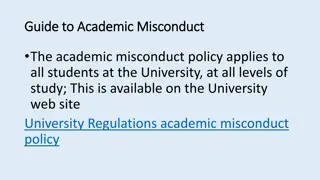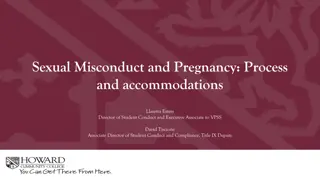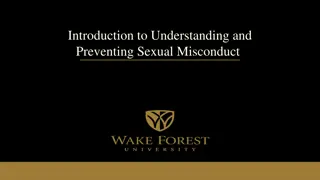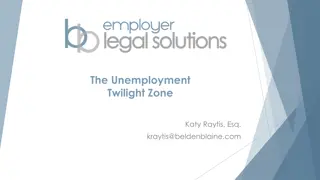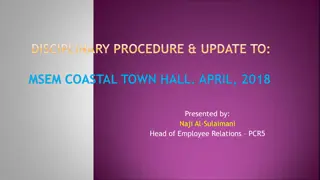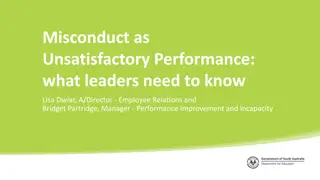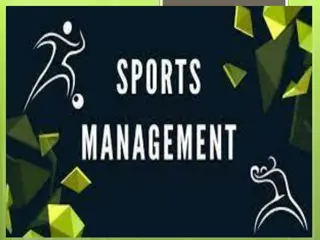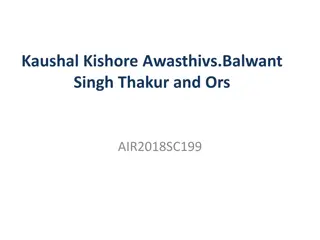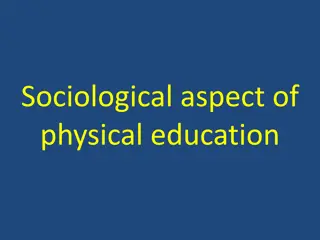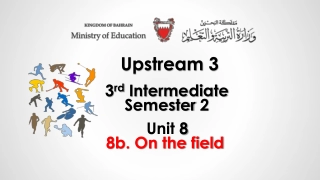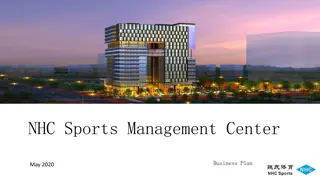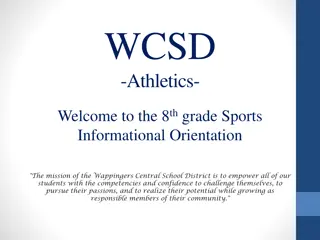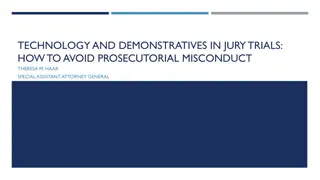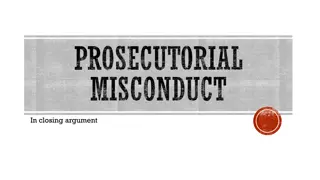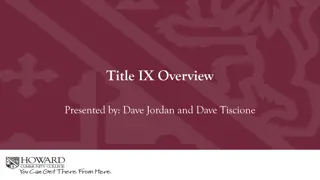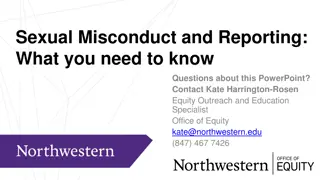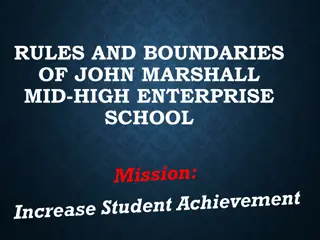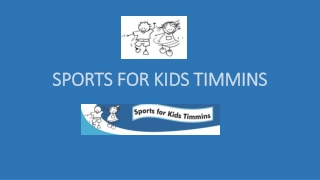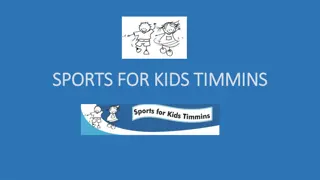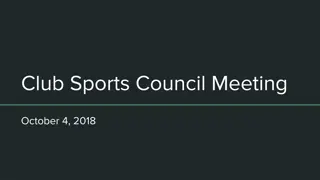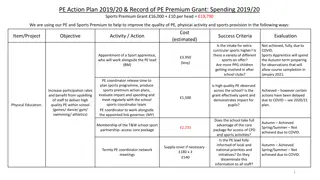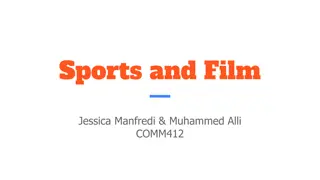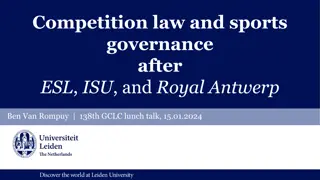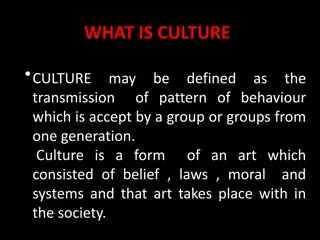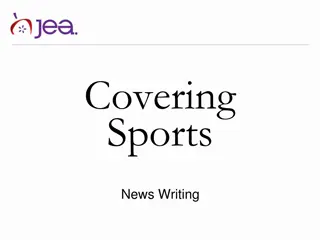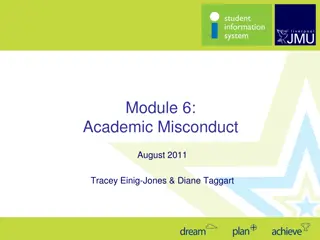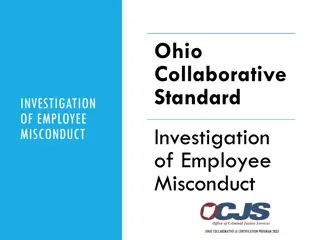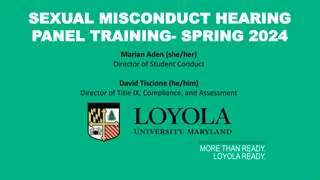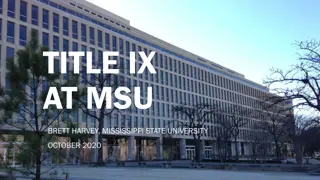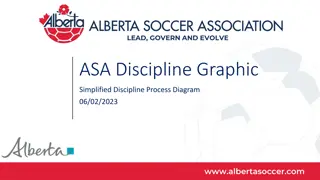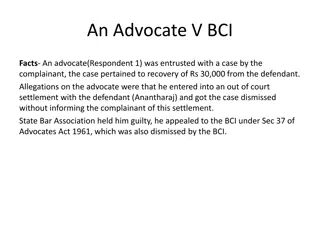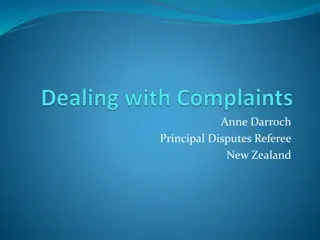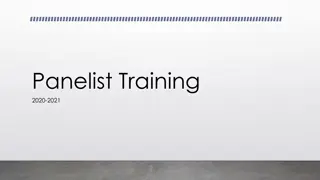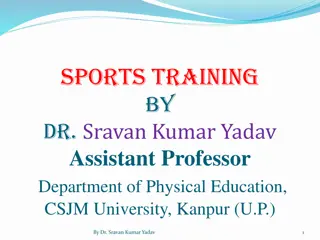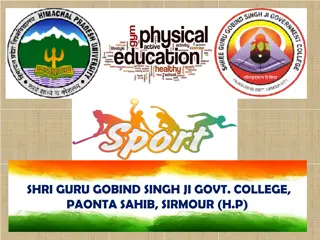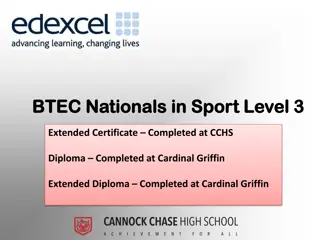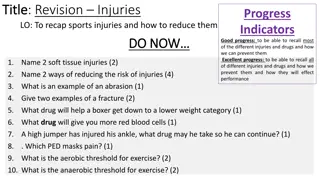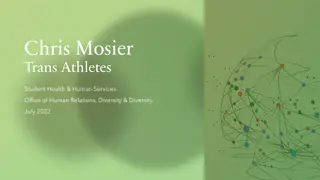Understanding Misconduct Rules in Sports
Explore the rules and procedures for handling misconduct in sports events, including the issuance of red, yellow, and blue cards. Learn about the NFHS Rule 12.8 and FHSAA Guidebook 4.10.1.1.3, along with examples and important considerations. Understand when and how to issue cards based on different violations, ensuring fair play and adherence to regulations.
Download Presentation

Please find below an Image/Link to download the presentation.
The content on the website is provided AS IS for your information and personal use only. It may not be sold, licensed, or shared on other websites without obtaining consent from the author. Download presentation by click this link. If you encounter any issues during the download, it is possible that the publisher has removed the file from their server.
E N D
Presentation Transcript
RED, YELLOW, or BLUE What s Required? FHSAA WEBINAR
Misconduct AGENDA RED, YELLOW, or BLUE What s Required? Misconduct: Rules and Where to Find Them NFHS Rule 12.8 FHSAA Guidebook 4.10.1.1.3 Procedures for Red, Yellow or Blue: When to Issue How to Issue Important Considerations Examples: You Make the Call Q&A:
NFHS Misconduct NFHS MISCONDUCT RULES 12.8.1
NFHS Misconduct NFHS MISCONDUCT RULES 12.8.1
NFHS Misconduct NFHS MISCONDUCT RULES 12.8.1
NFHS Misconduct NFHS MISCONDUCT RULES 12.8.1
NFHS Misconduct NFHS MISCONDUCT RULES 12.8.2
NFHS Misconduct NFHS MISCONDUCT RULES 12.8.2
FHSAA Misconduct FHSAA RULE 4.10.1.1.3 4.10.1.1.3 Card System for Misconduct. Administration of the Card System for Misconduct in all contests must be administered as follows: (a) A player, coach, or bench personnel who commits any of the violations listed in NFHS Rule 12-8-1 (a-f(1-11, 13-14)) shall be shall be cautioned (issued a yellow card). A player may be substituted for immediately, and shall be required to leave the field until the next legal substitution opportunity. An official may issue a red card and disqualify (eject) a player, coach, or bench personnel on a first offense if the situation warrants. (b) A player who commits a second violation of any of the violations listed in NFHS Rule 12-8-1 (a-f(1-11, 13-14)) shall be issued a second caution (blue card), shall be disqualified (ejected) from further participation in the game and shall not be replaced on the field with a substitute. The official shall first show the yellow card by raising the card above the head, followed by raising the blue card above the head. (Note: the yellow and blue cards shall not be shown simultaneously).
FHSAA Misconduct FHSAA RULE 4.10.1.1.3 4.10.1.1.3 Card System for Misconduct. Administration of the Card System for Misconduct in all contests must be administered as follows: c) A coach or bench personnel who commits a second violation of any of the violations listed in NFHS Rule 12-8-1 (a-f(1- 11, 13-14)), or a first offense of NFHS Rules 12-8-1 (g), 12-8-1 (f) (12), or 12-8-2 (a-c, d(1), e-f) shall be issued a red card, shall be disqualified (ejected) and must exit the premises, and shall be subject to the provisions of the FHSAA Policy of Unsporting Conduct. d) A player who commits any of the violations listed in NFHS Rules 12-8-1 (g) or 12-8-2 (a-b, d(1), e-g) shall be guilty of unsporting conduct, shall be issued a red card, shall be disqualified (ejected) from further participation in the game and shall not be replaced on the field with a substitute. This player shall be subject to the provisions of the FHSAA Policy on Unsporting Conduct.
FHSAA Misconduct FHSAA RULE 4.10.1.1.3 4.10.1.1.3 Card System for Misconduct. Administration of the Card System for Misconduct in all contests must be administered as follows: e) A player who violates NFHS Rule 12-8-2 (d) (2) shall be guilty of a hand ball foul (non-contact with opponent) and disqualified (ejected). The player shall be issued a blue card and shall not be replaced on the field with a substitute. 4 2019-20 FHSAA Soccer Sport Manual f) A player who violates NFHS Rule 12-8-2 (d) (3) shall be guilty of committing a foul (non-violent) attempting to deny an obvious goal-scoring opportunity outside the penalty area, and shall be disqualified (ejected) from the contest. The player shall be issued a blue card and shall not be replaced on the field with a substitute.
FHSAA Misconduct FHSAA RULE 4.10.1.1.3 4.10.1.1.3 Card System for Misconduct. Administration of the Card System for Misconduct in all contests must be administered as follows: g) A player who violates NFHS Rule 12-8-2 (d) (4) shall be guilty of committing a foul inside the penalty area, while not attempting to play the ball and a goal is not scored and shall be disqualified (ejected) from the contest. The player shall be issued a blue card and shall not be replaced on the field with a substitute. h) A player who violates NFHS Rule 12-8-1 (f) (12) shall be guilty of delayed, excessive or prolonged act(s) by which the player attempts to focus attention upon his or herself and/or prohibits a timely restart to the game and shall be disqualified (ejected) from the contest. The player shall be issued a blue card and shall not be replaced on the field with a substitute.
Blue Cards BLUE CARD OFFENSES What is a blue card? If an athlete receives a blue card, the athlete is ejected from the game and cannot be replaced (the team will play short an athlete for the remainder of the game). That athlete is only ejected for the rest of the game with no additional penalty for future games.
Red Cards RED CARD OFFENSES What situations necessitate the issuance of a RED card? RED cards are issued when the following situations occur: 1. Violent Conduct. 2. Taunting use of words or act to incite or degrade an athlete, coach, referee or other individuals. 3. Any play in which an athlete commits a foul and uses disproportionate and unnecessary force against an opponent. 4. Spitting at an opponent, teammate, or game official. 5. Using insulting, offensive, or abusive language or gesture. 6. Leaving the team area to enter the field where a fight or altercation is taking place, unless summoned by a game official. 7. A Coach or Bench Personnel that receives a second Yellow Card 8. Violation of NFHS 12.8.1.g Use of Tobacco products
Rule Change DOGSO RULE 12-8-1F, 1, 12-8-2D(3), 12-8-2D(4) Clarifies the penalty for a player who denies an obvious goal-scoring opportunity.
Points of Emphasis DENYING AN OBVIOUS GOAL-SCORING OPPORTUNITY (DOGSO) Recently, the penalty associated with a player who denies an obvious goal-scoring opportunity has been amended. In an effort to make the penalty better fit the infraction, now when a player commits an offense against an opponent within his/her own penalty area which denies an obvious goal-scoring opportunity and the referee awards a penalty kick, the offender is cautioned if the offense was an attempt to play the ball.
Points of Emphasis DENYING AN OBVIOUS GOAL-SCORING OPPORTUNITY, CONT. Formerly, this player was disqualified and penalty kick was awarded. In circumstances where there was no attempt to play the ball, the player is still disqualified. (BLUE CARD)
Points of Emphasis DENYING AN OBVIOUS GOAL-SCORING OPPORTUNITY, CONT. In evaluating whether there has been an obvious goal-scoring opportunity, officials are encouraged to consider the following: Distance between the offense and the goal (the offense must be near the goal). General Direction of play (the attacking players are generally headed toward the goal). Likelihood of keeping or gaining control of the ball (the player must have or be able to get control of the ball in order to score). Distance to the ball.
Points of Emphasis DENYING AN OBVIOUS GOAL-SCORING OPPORTUNITY, CONT. Location and number of Defenders (not more than one defender between the attacking player and the goal, not counting the player who committed the foul and the defenders must be able to challenge the attacking player). If any of the above considerations are missing, it is not an obvious goal-scoring opportunity.
Points of Emphasis OFFICIALS COMMUNICATING MISCONDUCT TO COACHES NFHS Rule 5-3 states that game officials shall communicate the nature of misconduct to coaches, the scorer and other officials when a yellow/blue/red card has been issued. This communication is a notification and not an explanation. It is not intended to be an opportunity for the coach to discuss or dissent the call. It is, however, an educational opportunity for the coach to address and/or correct the behavior of the carded individual.
Points of Emphasis OFFICIALS COMMUNICATING MISCONDUCT TO COACHES The referee shall communicate the nature of the misconduct to coaches, the scorer and other officials when a yellow/red card is issued.
Points of Emphasis UNDERSTANDING THE DIFFERENCE BETWEEN FAIR, HARD PLAY AND A FOUL. Soccer is a contact sport and understanding the differences between fair and hard play and a foul that is either reckless or serious is important to ensuring fair play and the safety of the players. When a player acts with disregard of the danger to, or consequences for, the opponent, he/she should be cautioned for reckless play. When a player uses disproportionate and unnecessary force against an opponent, he/she could be disqualified for serious foul play. It is critical coaches teach players about their own safety and the safety of their opponents, and officials recognize the differences between reckless and serious and the corresponding penalties. Safety, fair play and sportsmanship should be emphasized in the pregame meeting. Communication between officials, coaches and captains should continue throughout a match, especially as the intensity increases. And when reckless or serious foul play occurs, officials should deal with the situation immediately this kind of play should not tolerated.


